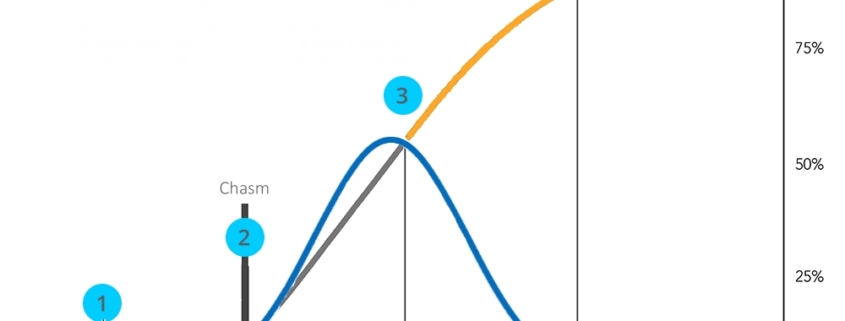It takes unique cognitive abilities or so-called soft skills or talents to get you to groundbreaking innovation.
Talents or Soft Skills matters – in some cases, even more than hard skills. One of those cases is with Innovation Development. Creating a groundbreaking innovation needs a new perspective, open-mindedness, creativity, courage, and other cognitive abilities deeply ingrained in a person’s mind. We prefer ‘Talent’ over ‘Soft Skill’. A skill is something people can get by training on. Talent is something that has evolved early in a person’s life, beginning as a newborn. For the sake of this post, let’s use talent as something we are looking for when attracting innovation team members.
Cognitive abilities as a Critical Success Factors of Innovation Teams
About ten years ago, we asked ourselves, what critical skills an innovative mind should have? After many long discussions, we realized: No skills at all. We learned that 20-year-old innovators with no developed skills could quickly create unique ideas and form a company. An early reaction was that age is a crucial factor for innovators. Startups should be run by young people that are unbiased and can change the world. Later on, we all learned that 50-year-old Elon Musk unfolded his full potential in the mid-30s. Regardless, all highly successful innovators have a few things in common, independent of age, skills, or educational background – TALENTS.
Those top innovators are without exception highly curious, very courageous, continuous, or relentless in their execution and exceptional collaborators. While looking deeper into the fabric of the innovator’s talent, we discovered eight key aspects: Curious, Courageous, Continuous, Collaborative, Creative, Communicative, Confident, and Connected. You may wonder what about PASSIONATE? We put it consciously out. Passion is not necessarily a specific talent or wiring in one’s brain – it is a result of a particular neurological trigger. Any person can be extremely passionate about something. Passion is undoubtedly a success factor for innovators but not a talent.
The 8 Cs of innovation talent
Curious, Courageous, Continuous, Collaborative, Creative, Communicative, Confident, and Connected
 (1) Curious
(1) Curious
We learned that new ideas are composed of past experiences. Unrelated experiences to solve a problem or create a new solution are especially valuable. People who are curious above average have more and broader spread experiences than others. Curiosity is also an essential talent when learning how customers work today and what it may take to make a significant improvement. In some cultures, curiosity has a slightly negative connotation as it is used for people snuffing around other people’s private life. However, curiosity is a key driver in knowledge acquisition driven by an interest and not so much by an external force to learn something. That mind-driven curiosity makes a person find out things to satisfy the overall interest or the interest in the context of a purpose. Why want people to get faster with their car? What distances do they go? How important is it to be on time? What do they do while driving for 5 hours? What are the alternatives? What would be the most convenient way? Even if we don’t have fast trains, would they use it if ……? In the innovation space, innovation teams need to ask questions that may have never been asked. They need to construct their own paths to acquire knowledge that may not be available in that form. What is the max width of a train trace to make narrow curves at 300 miles an hour? This is not about having ideas – but all about asking related or connected but unrelated questions.
 (2) Courageous
(2) Courageous
When radically new thoughts get created, it takes a lot of courage to share them with others. It takes courage to stand your ground, despite others laughing at you. In an enterprise, it takes courage to push for a change and, at the same time, take the risk to get fired. Courageousness is the basis for bold thoughts. It allows to break any rule except the law. And if the law is hindering innovation it takes courage to make all efforts to change the law. Innovation is not just inventing new products but also building new business models. Should it be necessary to question the current business model, then it needs to be discussed. If the company’s structure is in the way to bring radically new processes forward, it takes courage to say so and not only mention it but make every possible attempt to make it happen. Genuine innovation is touching many people; employees, customers, partners, vendors, alliances, unions, and possibly many more. It takes courage to not stop at this overwhelming undertaking but to work through all the groups, interests, and aspects that may need attention. Enterprise employees are typically best when they follow the rules, don’t question the set structure, and get great results fast. Courage is not part of the recipe to success – but it exists in many people without using it in business but in sports or hobbies.
 (3) Continuous
(3) Continuous
Brilliant ideas are just an episode in the entire innovation effort. Relentless execution makes innovative ideas and concepts a genuine innovation. Missing that duality between ideation and execution is why so many innovation projects failed. Successful innovation is the entire work from pre- ideation market observation to a multi-year engagement to scale the new solution globally. Innovation teams, therefore, need to be continuous in their work. Never give up and never surrender. Once an idea is found the innovation team will want to validate the idea, make sure to finance the project and then bring it successfully to market. There is no known case where the existing organization was able to bring an innovation to market. The only exception may be if the company is virtually dead and has nothing to sell anymore and the innovation is their last hope. The innovation process is a 5 to 10 years marathon. Look at any significant innovation created in the past 50 years; you won’t find a single one that became globally successful in less than five years. It simply takes time to make a dream a reality. It isn’t because all the teams so far were slow – it is the adoption time of conservative buyers, which represents the most significant part of almost any market.
 (4) Collaborative
(4) Collaborative
Sharing ideas, not owning them, is part of a strategic ideation process component called Idea Confluence. Working with others to extend the brainpower and accumulate more ideas is critical in the ideation process. Also, when ideas are realized or brought to market, the innovation team needs to be highly diverse but also collaborative in every aspect of their work. When in exchange mode, ten brains produce more than ten times as much value than just one time ten. The time of solopreneurs or isolated researchers or engineers is over. Not that they cannot come up with good ideas, but they won’t outperform a diverse team of ten amazing brains. And a well-assembled team is usually 5 times faster in the market than a single expert – no matter how smart he or she is.
Moreover, collaboration is far more than a team sport. Innovation terms need to know their limits and quickly pull external experts, science, research into the operation. If an innovation team member is not collaborative, their knowledge and experience would not be shared, discussed, extended, and so forth, and therefor that team member is far less valuable in an innovation team.
 (5) Creative
(5) Creative
Creativity has very many faces. In the innovation space, creativity is not only creative ideas but also creative business models, creative ways to produce things, creative ways to finance development, get to the market, and more. Creativity in the innovation space means going ways nobody else went. Creativity is the talent to connect many unrelated things, thoughts, or experiences, construct them in their head, and come up with a structure, shape, process or anything of that order that has just not been done but at the same times provides a significant advantage over what exists today. Creativity to be different is of no help in the innovation space; however, when created in a collaborative effort, it may trigger new ideas and new structures in somebody else’s brain. Creativity, in a collaborative process, is what makes innovation work. An innovation team member lacking creativity will very quickly feel uneasy, not contributing, and not successful.

(6) Communicative
Compared to other biological life forms, one of the most significant advantages of being human is communicating thoughts and visions for the future. That talent is needed in every phase of innovation, every collaborative event or meeting, every ideation session, and every other collaborative engagement. The more communicative a person is the more content of their thinking gets across. A big innovation dilemma is that the human brain can think extremely fast and has a large number of thoughts and ideas within milliseconds but can’t communicate them at the same speed. Communication talent is key for every innovation team member. The best thoughts, ideas or brain constructs are rather limited of value when they cannot be communicated. Communication talent is not only important during the ideation processes. Communication becomes extremely important when it comes to involving others. Those “others” include early customers when it comes to idea validation, the management team when it comes to approval financing of the concept, business partners when it comes to the early building and production validation, the market when this radical innovation needs to attract its early adopters.
 (7) Confident
(7) Confident
Confidence is needed in communication, motivation, investment phases, and in the interaction with the market. Confidence is derived from very well-thought-out solutions and concepts that have been explored from hundreds of different aspects. Confidence is not about convincing others but transforming a vision into a realistic model that others can adapt as well. Confidence is needed by every innovation team member as the new “thing” needs to be explained with confidence to attract others. Confidence is an essential connection in the brain between a variety of aspects of a brand new solution. In particular, knowing it will help many people, realizing it is possible to build what is shown, and knowing that even if not everything works today, it will be possible to make it work in the coming years. Confidence is a form of being visionary by translating all that is known about that envisioned future today will be possible through certain actions that are yet to happen. At the same time confidence is not being afraid to say that there is no guarantee about the anticipated outcome.

(8) Connected
And finally, a strong networking ability connects a person with relevant people from all backgrounds and levels. Connection skills are critical when unique expertise is needed to augment an innovation team. Ideaconfluence sometimes requires very rare experiences or skills that are not present in the innovation team. Making those connections in timely order – typically on the same day is a talent that every innovation team member should have. Well-connected people are inherently open and open-minded, involving others in whatever needs to get done.
Isn’t Passion a Cognitive ability?
So what about passion? Being passionate is not a soft skill to qualify for an innovation team member in general. People can be passionate about anything – they can even be obsessed about anything. We learned that passion or obsession kicks in if a specific action or environment, religion, or people captivates one so much that they can’t stop being engaged. Suppose everybody can develop passion about what they care about most. In that case, it is not a soft skill to probe for – but – it is utterly essential to find out in an interview process if innovation in your space would be a passion for the candidate.
Open-minded and other traits
In our research, we found that people with the above eight Cs are inherently open-minded. Openness is a relatively fast identifiable characteristic of a human but doesn’t necessarily include our talents. But to the contrary, people with the 8 Cs are always open-minded. Otherwise, those specific abilities would not show. This is true for many other soft skills that seem to be important in innovation but indicate some of the other talents we mention here. However, we want to clarify that we are just at the beginning of understanding the brain’s ability to compose ideas and what it takes to get there. We continuously research behaviors during innovation processes and learning as fast as possible, including using tools like AI to improve our work and results.
Testing Talents /Cognitive Abilities
Unlike well-trained and adopted hard skills, it seems that testing soft skills or cognitive abilities is not so easy. Exploring the soft skills of a job candidate is far more difficult today as there is only little experience. Hard skills are trained and the person will need to repeat what they learned or applied and then get tested on the results. Those repeat/linear jobs are rather easy to test while lateral activities like being curious, communicating, being creative, and so forth have no exact outcome as they have no exact input.
Here are a few tips for testing a candidate for specific soft skills. Instead of having multiple-choice questions or questions that you expect either a right or a wrong answer, try to understand how they behaved in certain situations by asking questions about their experience in various situations.
- Ask them to remember a situation or time where they had to solve a problem that they never had or don’t know anybody who solved it.
- Ask them to remember a scene where they had to help another college while they were under stress themselves.
We will publish a separate blog post just on soft skill testing and probing.
Where to find the best talents?
Most business managers tend to hire their innovation dream team from the outside. Reasons may include that they don’t trust their own culture, don’t know anybody who has the right profile, or fears that the organization already blinds them. However, our research indicates that most enterprises that desire to innovate have the top talents already in-house. We have seen amazing creative and ingenious people in all kinds of departments within enterprises. Attracting talents from within the organization has various advantages. It would help if you did not fear that they may already be blinded by the way things work in the company. If they have the 8 C’s as soft skills they will make a better organization and culture faster and with more intensity than newcomers.
Summary
- Make yourself familiar with the value of the 8 C’s
- Look inside your own organization first
- Make sure you have a very compelling offering
- Be aware that you will deal with exceptional talents that other companies will try to hire away.
- Don’t protect your talents, give them a dream environment
- It takes teamwork to make a dream work
Looking for a career in the fast-growing innovation space. Take the Innovation Talent Test to see if you have the 8C’s to start your innovation career opportunity.








 (1) Curious
(1) Curious (2) Courageous
(2) Courageous (3) Continuous
(3) Continuous (4) Collaborative
(4) Collaborative (5) Creative
(5) Creative
 (7) Confident
(7) Confident




